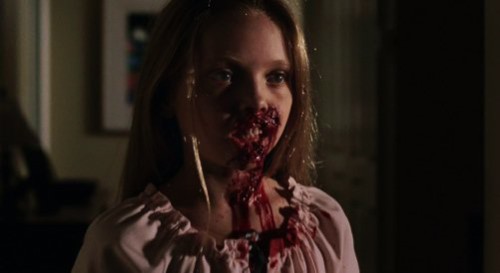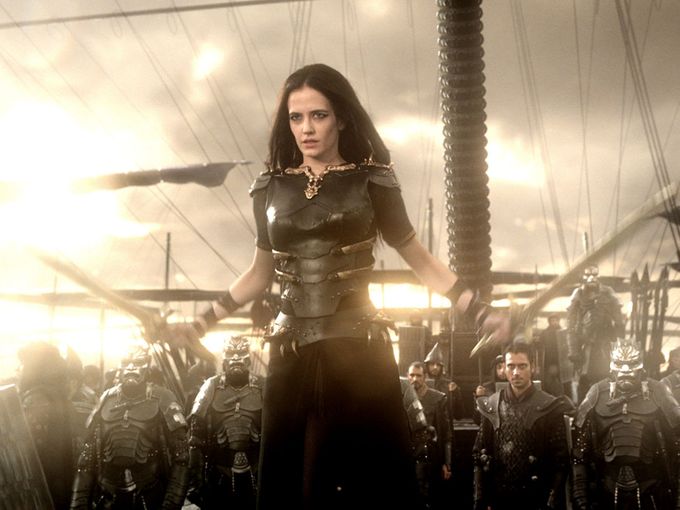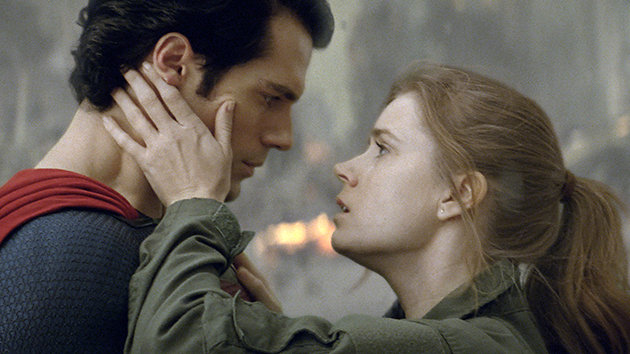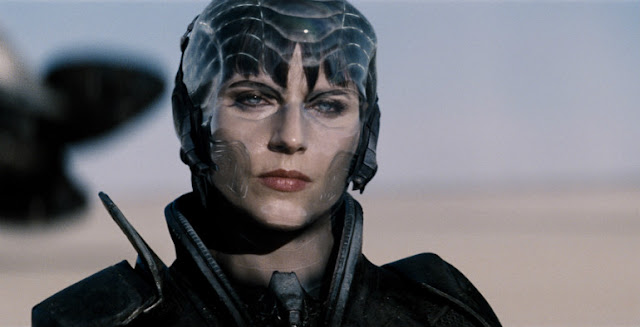This guest post by Emily Katseanes appears as part of our theme week on Dystopias.
George Romero’s 1978 zombie flick Dawn of the Dead opens in a newsroom. As the world descends into chaos, darkness and violence, two talking heads are deadlocked into an intellectual debating about the causes of what’s killing so many people and then bringing them back. The theme of humanity’s utter banality and pettiness is backed up as we meet our main character, Francine, who is trying to get her boss to stop broadcasting inaccurate shelter station locations at the bottom of their screen. Even the 2004 remake of this movie repeats this cynicism. Zack Snyder’s film of the same name includes a particularly gruesome scene in which a human husband restrains his pregnant, zombie wife, keeping her alive to birth an undead child, which of course, causes the outbreak to take down the rest of the remaining humans.

The message in both cases is overwhelmingly clear: the post-apocalyptic zombie landscape is one in which the violence of the undead’s feasting is small potatoes compared to man’s inhumanity to fellow man. It’s a familiar theme in both dystopian and zombie genres.
And that’s what makes Warm Bodies such an interesting dystopian flick: The film deftly defies expectations by presenting a world gone to hell that’s still full of humanity and, dare I say it, romance. The 2013 film centers around a charmingly vulnerable and mostly decay-free Nicholas Hoult as R, a zombie with a heart of gold and a reluctance to resort to the monstrous behavior normally associated with the undead. Partway through the film, he encounters Julie (Teresa Palmer), a tough, tender, and fully alive human girl. The two form a friendship and, later, romantic relationship. The star-crossed lovers’ relationship sets off a chain reaction that ends up rehabilitating most of the undead and uniting them with the living against the malicious, more-decayed Boneys.
The film first defies the genre by blending the zombie gross-out factor with a teenage romance, as if George Romero and John Hughes collaborated on a script. But beyond that, Warm Bodies stoutly rejects the pessimism that haunts the hellscapes that are Romero’s zombie America and Hughes’ Shermer, Illinois high schools. Instead, the film fully embraces all the messiness of the Millennial and manages to make an argument for hope in that most maligned generation.
Hoult’s character R is the narrator and driver of the plot. He’s a deadpanned young dude, given to quips such as this introduction to his best friend Marcus, played humorously by Rob Coddry: “This is my best friend. By best friend, I mean we occasionally grunt and stare awkwardly at each other.”
R’s blend of irony and sincerity—he really does count Marcus as a friend even as he pokes fun at the concept—registers well with the Millennial attitude. Hoult, who’s even Millennial enough to be the subject of a Buzzfeed listicle, is outfitted as well as any Brooklynite or San Franciscan can be who’s cool without trying to be too cool. He wears a red hoodie with skinny jeans and lives in an airplane bedecked with a record player and other irony-heavy objets d’art, such as a bobbleheaded Chihuahua and an old-fashioned viewfinder.
R, as befits the stereotype of the Millennial hipster, is sensitive almost to a punch line. He laments the loss of the pre-zombie world not for its safety or conveniences, but for a population that “could express themselves, and communicate their feelings and just enjoy each other’s company.” (In that most-Millennial blend of irony and sincerity again, the movie plays off a visual gag, showing a world of everyone sucked into smartphones, even as R’s voiceover remains serious.)
Julie, on the other hand, reads as a woman of the new Millennium, albeit differently. Although she’s not the bespoke-wearing, Zooey Deschanel, quirky girl who handcrafts and bakes, she’s a woman in the vein of Scandal’s Olivia Pope or The Mindy Project’s Mindy Lahiri. She’s traditionally feminine and yet stoic, independent and able to hold her own against any men (including her dad, played by John Malkovich). Whereas R is the perpetually awkward, sensitive boy, Julie is cool, competent and clad in plaid.

Beyond aesthetics, R and his fellow fresher zombies, called “u,” increasingly follow Millennial markers. They’re more listless than ravenous, underwhelmed rather than driven by rage and seem, more than anything, bored by the routines of middle-class life. R and Marcus meet to hang out at an airport bar and other zombies are seen going through the motions of their pre-death jobs. But, again echoing Millennials and the fraught economy they came of age in, it’s a middle-class lifestyle that’s no longer accessible to them. In an economic recession that renders a 9-to-5 with a travel expense account almost as mythical as a zombie, the lifestyle that Marcus portrays of the traveling businessman is as far away for Julie and R as it is for most 18- to 24-year-olds.
R and Julie also tap into the somewhat aimless creativity of the hipster/Yuccie generation. They’re creative, but it’s geared toward no particular endeavor. Julie and R aren’t poets, painters, or revolutionaries. Their creativity expresses itself as curators: of clever one-liners, tastefully decorated rooms, and arty Polaroids of each other. They’re lifestyle bloggers for the post-apocalyptic youth.
All of this makes the dystopia of Warm Bodies at once threatening and not threatening at all. While the zombie threat is a plot catalyst, the actual undead shamblers often take a backseat to the interactions between the two leads. And that’s where Warm Bodies’ genre subversion really takes off. Like all dystopian flicks, it’s a commentary on our current world. The difference is that while most films in this genre present characters who are oblivious or somehow unaware of the lurking catastrophe humanity’s bringing upon itself, Warm Bodies presents characters who are well aware the world’s already gone to hell. They’re just not going to buy into all that negativity, man.

And that’s not just a twist on the zombie dystopia. It’s a twist on how R and Julie’s generation is painted throughout media.
In addition to being the main characters, R and Julie are the happiest. In a world that’s fraught with danger and starvation, most of the other humans and zombies on screen seem to experience only fear and grim determination. In one of their early scenes together, R and Julie drive a red convertible. It’s a familiar scene of carefree enjoyment, whooping and hollering as they speed around.
But even beyond that, Julie and R are successful. They’re the ones who enact change in the world, creating a “cure” for zombie-ism by getting the undead creatures to feel love again. And they do it by proving the Millennials’ critics simultaneously right and wrong. R, Julie and their allies end up shifting the world by doing…not much of anything. It’s Julie and R’s simple affection for each other, born of those afternoons taking Polaroids and dancing to records, that gets the zombies feeling, dreaming and living again.
R and Julie have opted out of the capitalist conveyor belt that turns humans into braindead zombies and or war-mongering huddled masses. While it could also be read as a fundamental laziness to even stand up for themselves, the two succeed by not fighting. It is the peaceful revolution hippies of the 1960s might have wanted or it’s the ultimate move by a generation of wimps.
But whatever it is, it works. It changes the world, for the better. And that’s a narrative that’s not only missing from most dystopias, but from many depictions of the current generation. Of course, like a lot of narratives about Millennials, this remains problematic. The world of Warm Bodies is overwhelmingly white and the characters read as upper-middle class. In a film arguing for optimism for the youth, it’s both telling and disappointing that the youth included are white and affluent. There’s still a long way to go to get our representations to actually reflect the demographic of the world they exist in. It’s also easy to blow off the movie as teenage fluff and in a way, it is. It’s a cutesy romance that uses Shakespeare’s Romeo and Juliet as a skeletal structure and adds a killer soundtrack and a budding romance to flesh it out. But like R, who (mild spoiler alert), becomes human by the end of the film, it’s a vision of humanity that grows less not more fetid as it goes on.
A native Nevadan, Emily Katseanes has degrees from the University of Nevada and New Mexico State University. She has done everything from cleaning houses to filing fatality information at a gold mine to reporting on city council meetings in rural Idaho. Currently, though, she works her favorite job of all: teaching English at Louisiana State University.















